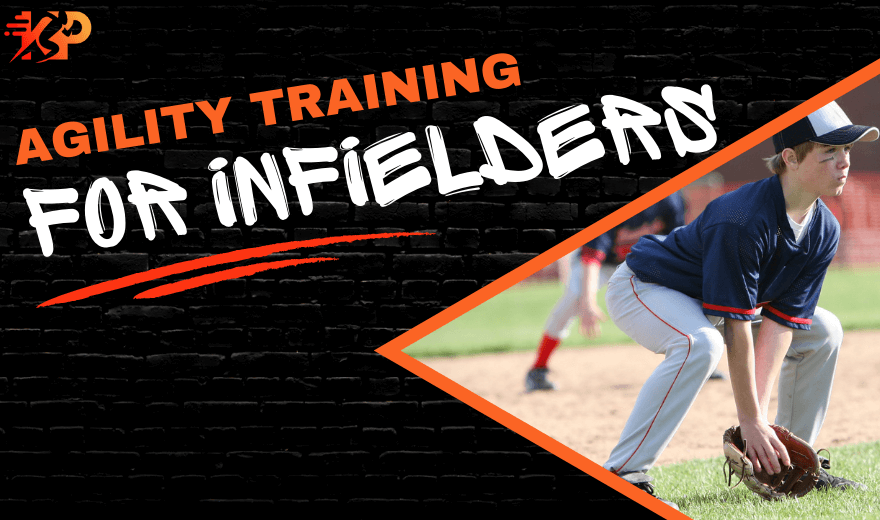Agility Training for Infielders: Quick Reflexes and Faster Throws

By Mark Keil, CSCS
Posted on August 24, 2024

By Mark Keil, CSCS
Posted on August 24, 2024

The infield is high-pressure. Quick reflexes and precise movements can turn the tide of a game in a second.
Infielders are responsible for reacting to hard-hit ground balls, executing double plays, and making quick, accurate throws to get runners out. Their ability to move swiftly and efficiently across the dirt is crucial, and agility training plays a significant role in this.
This article will explore agility drills to help infielders improve their reflexes, footwork, and throwing speed, enhancing their overall defensive performance.
The Importance of Agility in the Infield
Agility is the ability to move quickly and change efficiently. For infielders, agility is not just about speed; it’s about making quick, sharp movements that allow them to react to various situations—whether a fast grounder, a bunt, or a steal attempt. The infield is where the action happens in split seconds, and an infielder’s ability to respond rapidly is necessary.
Moreover, agility contributes to an infielder’s throwing accuracy. After fielding a ball, infielders must quickly set their feet and make a precise throw to a base. This movement requires balance, coordination, and power, and can be enhanced through targeted agility training.
Essential Agility Drills for Infielders
To develop the agility necessary for high-level infield play, incorporate drills focusing on quick footwork, lateral movements, and explosive power. Below are some of the most effective agility drills for infielders:
1. Ladder Drills
(Click here for a full tutorial on how ladder drills improve performance in baseball athletes).
Objective: Improve foot speed, coordination, and quickness.
Execution:
- Place an agility ladder on the ground.
- Perform various footwork patterns through the ladder, such as high knees, lateral shuffles, and in-and-out steps.
- Focus on quick, precise movements while maintaining control.
Benefits: Ladder drills enhance the quick-twitch muscle fibers in the legs, allowing infielders to move their feet rapidly and efficiently. Quick foot movement is crucial for getting into position to field grounders and making quick throws.
2. Cone Drills (for example, the T-Drill)
Objective: Develop lateral agility, change of direction quickness, and the ability to react quickly to game situations.
Execution:
- Set up cones in a pattern that requires rapid direction changes, such as “T” shape (T-Drill). Set the start cone on the ground, walk 10 yards forward, and place the middle cone on the ground. Then, walk five yards from the middle cone to the left and place the left cone on the ground. Then, walk past the middle cone 5 yards to put the right cone on the ground (the cones should now be in a ‘T’ shape.
- Sprint to the first cone, break down, and shuffle to the left.
- Touch the left cone with the left hand, then shuffle to the right cone.
- Touch the right cone with the right hand, then shuffle back to the middle cone.
- Then, backpedal from the middle cone back through the start cone.
Benefits: Cone drills replicate the lateral movements and direction changes infielders must make during a game. By practicing these drills, players can improve their ability to move quickly from side to side, making them more effective at fielding ground balls and bunts.
3. Short Burst Sprints
Objective: Enhance explosive speed and reaction time, which is critical for infielders when charging a slow roller or quickly moving to cover a base.
Execution:
- Mark out a short distance, such as 10 to 15 yards.
- From a ready stance, explode into a full sprint to the mark.
- Emphasize a quick start and maximum speed over the short distance.
- Repeat with varying starting positions, such as from a crouch or a lateral stance.
Benefits: Short burst sprints mimic infielders’ explosive movements when reacting to a hit ball. This drill builds the power and speed needed to charge a slow roller or quickly cover ground to make a play.
Integrating Agility Drills into a Training Regimen
For infielders, agility training should be a consistent practice routine. To maximize the benefits of these drills, the athlete must preform a proper warm-up, train consistently, and allow for adequate rest and recovery between training sessions.
Warm-Up: Always start with a dynamic warm-up that includes stretching, light jogging, and mobility exercises. The warm-up prepares the muscles and joints for the intense movements required in agility drills and reduces the risk of injury.
Consistency: Agility is a skill that improves with repetition. Regularly incorporate these drills into your practice routine to develop muscle memory and improve overall performance.
Rest and Recovery: After a session of agility drills, cool down with static stretching to aid recovery. Ensure adequate rest between sessions to allow the muscles to recover and adapt, reducing the risk of overtraining.
The Impact of Agility Training on Infield Performance
The benefits of agility training for infielders extend beyond physical improvements. By enhancing their reflexes, footwork, and quickness, infielders gain confidence in their abilities to handle the demands of their position. This confidence translates into more aggressive and decisive actions on the field, leading to fewer errors and more successful plays.
Conclusion
Agility is a cornerstone of effective infield play in baseball.
By incorporating targeted agility drills into the training regimen, infielders can enhance their reflexes, footwork, and throwing speed, making them better defenders.
If you have a baseball athlete, live in Tulsa, Oklahoma, and are looking for one of the Top Speed and Agility Training Programs near you, come check out my program for free. I’ve worked with JUCO, D1 Collegiate, and MiLB Baseball Teams and am confident my program will help your baseball athlete improve their speed and agility.
I train athletes weekly at World Baseball Outreach and have several class times available.
Have a question about Speed Training for your baseball athlete? Let me know!
Training Resources









